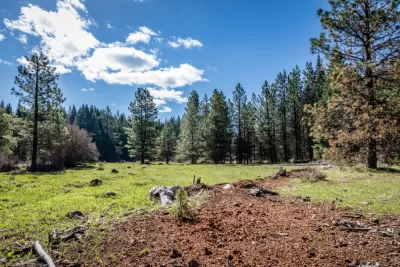The ecosystems of Oregon’s Coast Range are some of the most adept ecosystems for absorbing carbon in the entire country. The same trees that absorb that carbon can be turned into a major source of emissions in the hands of humans.

Carl Segerstrom reports on a surprising environmental dynamic at work in Oregon, revealed by a recent study authored by researchers at Oregon State University and the University of Idaho.
Less than a year after devastating fires ripped through some of the most beautiful areas in the state, a study published by the Proceedings of the National Academy of Sciences of the United States of America (PNAS) finds that logging and wood products are a larger source of carbon emissions in Oregon's forests than fires.
"Figuring out the role of forests and wood in carbon pollution could have major policy implications in Oregon, as Gov. Kate Brown has pledged to meet the emissions goals of the Paris Climate accords," according to Segerstrom.
Not only are fires a smaller source of carbon emissions, but "the wood products industry is the largest sector contributing to carbon pollution in the state," according to the study, as explained by Segerstrom.
"Wood product emissions are the result of fuel burned by logging equipment, the hauling of timber, milling, wood burned during forestry activities, and the ongoing decomposition of trees after they are cut," explains Segerstrom.
The researchers responsible for the study will next expand the concept to a larger swath of the Western United States.
FULL STORY: Timber is Oregon’s biggest carbon polluter

Americans May Be Stuck — But Why?
Americans are moving a lot less than they once did, and that is a problem. While Yoni Applebaum, in his highly-publicized article Stuck, gets the reasons badly wrong, it's still important to ask: why are we moving so much less than before?

Study: Maui’s Plan to Convert Vacation Rentals to Long-Term Housing Could Cause Nearly $1 Billion Economic Loss
The plan would reduce visitor accommodation by 25,% resulting in 1,900 jobs lost.

Placekeeping: Setting a New Precedent for City Planners
How a preservation-based approach to redevelopment and urban design can prevent displacement and honor legacy communities.

How the ‘Direct Vision’ Design Approach Saves Lives
Designing large trucks to ensure better visibility for drivers can reduce fatal crashes and improve workplace safety.

San Diego Swaps Parking Lane for Kid-Friendly Mini Park
The block-long greenway will feature interactive play equipment and landscaping.

Tracking the Invisible: Methane Leaks From LA’s Neighborhood Oil Sites
Environmental advocates are using infrared technology to monitor and document methane leaks from neighborhood oil sites, filling regulatory gaps and pushing for stronger protections to safeguard community health and the climate.
Urban Design for Planners 1: Software Tools
This six-course series explores essential urban design concepts using open source software and equips planners with the tools they need to participate fully in the urban design process.
Planning for Universal Design
Learn the tools for implementing Universal Design in planning regulations.
Caltrans
Heyer Gruel & Associates PA
Institute for Housing and Urban Development Studies (IHS)
City of Grandview
Harvard GSD Executive Education
Salt Lake City
NYU Wagner Graduate School of Public Service
City of Cambridge, Maryland





























